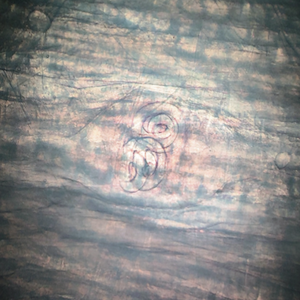Trichinella spp. detection in hunted wild boar (Sus scrofa) diaphragm biopsies in Central Italy

Accepted: 3 August 2023
HTML: 4
All claims expressed in this article are solely those of the authors and do not necessarily represent those of their affiliated organizations, or those of the publisher, the editors and the reviewers. Any product that may be evaluated in this article or claim that may be made by its manufacturer is not guaranteed or endorsed by the publisher.
Trichinellosis is a globally diffused foodborne parasitic disease caused by nematodes of the Trichinella complex. During evolution, guided by ecological interactions, natural selection, and biochemical “intelligence”, these parasites developed admirable strategies to infect the host’s organism. One of the most fascinating is represented by the nurse cell formation in muscular tissue (e.g., diaphragm, skeletal muscle, extrinsic ocular muscles, etc.). This strategy allowed the parasite to adapt and conquer the wider host species spectrum, including ungulates and humans. Consumption of undercooked meat from infected wild ungulates constitutes the most important source of infection for the human species. In this study, we show the prevalence of Trichinella spp. in hunted wild boars (Sus scrofa) in Central Italy. During the hunting season 2021/2022 in the province of Rieti, 554 wild boar diaphragm biopsies were collected for Trichinella spp. screening, in accordance with Regulation EU 1375/2015. An artificial digestion method was used for the detection of Trichinella spp. larval forms. The results revealed a positivity of 0.18% (1/554), and molecular biology identification demonstrated the presence of Trichinella britovi in the positive sample. This species is the most diffused in wild ungulate populations in Central Italy and the most frequently isolated in human patients with trichinellosis from this area, showing a close epidemiological relation between Homo sapiens and Sus scrofa for Trichinella spp. diffusion in an ecosystem. Epidemiological surveillance, in receptive animal species destined for human consumption and at any One Health level, represents the main “winning” strategy in the control of this worldwide, widespread foodborne parasitic disease.
Bruschi F, Ashour DS, Othman AA, 2022. Trichinella-induced immunomodulation: another tale of helminth success. Food Waterborne Parasitol 27:e00164.
Cammarota C, Marinari E, 2022. Ecologia e sistemi biologici nel paradigma di Parisi. Sapere 6:18-22. [Article in Italian].
Centers for Disease Control and Prevention, 2019. Trichinellosis. Available from: https://www.cdc.gov/dpdx/trichinellosis/index.html.
European Commission, 2015. Commission Implementing Regulation (EU) 2015/1375 of 10 August 2015 laying down specific rules on official controls for Trichinella in meat. In: Official Journal, L 212/7, 11/08/2015.
European Commission, 2020. Commission Implementing Regulation (EU) 2020/1478 of 14 October 2020 amending Implementing Regulation (EU) 2015/1375 as regards sampling, the reference method for detection and import conditions related to Trichinella control. In: Official Journal, L 338/7, 15/10/2020.
European Food Safety Authority, European Center for Disease Prevention and Control, 2022. The European Union One Health 2021 zoonoses report. EFSA J 20:7666.
Ferri G, Giantomassi G, Piccinini A, Olivastri A, Vergara A, 2023. Hepatitis E virus RNA detection from hunted wild boars in Central Italy: an epidemiological investigation. Food Environ Virol 15:158-66.
Ferri G, Lauteri C, Festino AR, Piccinini A, Olivastri A, Vergara A, 2022. Hepatitis E virus detection in hunted wild boar liver and muscle tissues in Central Italy. Microorganisms 10:1628.
Ferri G, Piccinini A, Olivastri A, Vergara A, 2022. Hepatitis E virus detection in hunted wild boar (Sus scrofa) livers in Central Italy. Ital J Food Saf 11:9979.
ISO, 2015. Microbiology of the food chain. Detection of Trichinella larvae in meat by artificial digestion method. ISO Norm 18743:2015. International Standardization Organization ed., Geneva, Switzerland.
Korhonen PK, Pozio E, La Rosa G, Chang BC, Koehler AV, Hoberg EP, Boag PR, Tan P, Jex AR, Hofmann A, Sternberg PW, Young ND, Gasser RB, 2016. Phylogenomic and biogeographic reconstruction of the Trichinella complex. Nat Commun 7:10513.
Kumar V, Abbas A, Aster J, 2014. Robbins & Cotran pathologic basis of disease. 9th ed. Elsevier, Amsterdam, Netherlands.
Marcato PS, 2002. Patologia sistematica veterinaria. 1st ed. Edagricole, Milan, Italy. [Book in Italian].
Nuzzolo-Shihadeh L, Camacho-Ortiz A, Villarreal-Salinas D, Barbosa-Quintana A, Pineda-Sic R, Perez-Alba E, 2020. Human trichinosis mimicking polymyositis. Int J Infect Dis 92:19-20.
Parisi G, 1980. A sequence of approximated solutions to the S-K model for spin glasses. J Phys A - Math Gen 13:L115-21.
Piccinini A, Ferri G, Olivastri A, Rossi F, Festino AR, Vergara A, 2022. Intradiaphragmatic abscesses in a wild boar (Sus scrofa): inspective implications based on anatomopathological evidences. Ital J Food Saf 11:10346.
Pozio E, 2016. Adaptation of Trichinella spp. for survival in cold climates. Food Waterborne Parasitol 4:4-12.
Pozio E, La Rosa G, 2003. PCR-derived methods for the identification of Trichinella parasites from animal and human samples. Methods Mol Biol 216:299-309.
Pozio E, Rinaldi L, Marucci G, Musella V, Galati F, Cringoli G, Boireau P, La Rosa G, 2009. Hosts and habitats of Trichinella spiralis and Trichinella britovi in Europe. Int J Parasitol 39:71-9.
Santos Durán-Ortiz J, García-de la Torre I, Orozco-Barocio G, Martínez-Bonilla G, Rodríguez-Toledo A, Herrera-Zárate L, 1992. Trichinosis with severe myopathic involvement mimicking polymyositis. Report of a family outbreak. J Rheumatol 19:310-2.
Troiano G, Nante N, 2019. Human trichinellosis in Italy: an epidemiological review since 1989. J Prev Med Hyg 60:E71-5.
Wang ZH, Peng WB, Zhang P, Yang XP, Zhou Q, 2021. Lactate in the tumour microenvironment: from immune modulation to therapy. EBioMedicine 73:103627.
Copyright (c) 2023 the Author(s)

This work is licensed under a Creative Commons Attribution-NonCommercial 4.0 International License.
PAGEPress has chosen to apply the Creative Commons Attribution NonCommercial 4.0 International License (CC BY-NC 4.0) to all manuscripts to be published.


 https://doi.org/10.4081/ijfs.2023.11467
https://doi.org/10.4081/ijfs.2023.11467



